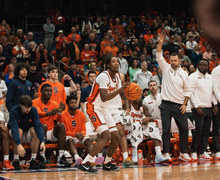Syracuse’s crows are the ‘spirit and soul’ of CNY
Jess Van | Contributing Photographer
As the sun sets, thousands of crows roost in downtown Syracuse trees. The birds travel in flocks throughout central New York including near the Syracuse University campus.
Get the latest Syracuse news delivered right to your inbox.
Subscribe to our newsletter here.
Four years ago, David Haas posted a sticker of a crow on a telephone wire with “I love Syracuse” above it. Crow fans flocked to Haas’ comments, begging for the design to be put on a shirt because of the bird’s long symbolism for the city of Syracuse.
“People don’t like Syracuse and I’ll always kind of joke back that it seems that the crows do,” Haas said. “I think a lot of people have love for the crow as an animal and a symbol of this city.”
The American crow settles, or roosts, in central New York during the winter, according to Kevin McGowan, a “crow expert” who works at the Cornell Lab of Ornithology. Crows have been documented roosting in well-lit areas, like Syracuse University, to avoid owls since the 1930s, he said.
They increased in population 30 years ago to about 30,000 in Syracuse and Cortland. Other areas of CNY, like where McGowan resides in Ithaca, have much smaller roosts. Syracuse and Auburn account for the largest roosts of the area, McGowan said.
“(Roosting) is just something that the crows do in winter,” McGowan said. “They like to get together, and talk about stuff someplace around in usually slightly lit areas where they can see owls coming – things like that.”
These high numbers of crows initially gained traction on social media pages like Haas’ @syracusehistory social media account. He now receives video submissions of the birds roosting in the trees or a cemetery, spurring passionate debates on whether people should love or hate the crow.
Haas teamed up with Eric Hart, the designer of the new Syracuse flag to create the newest @syracusehistory crow t-shirt. They combined the new city flag with a joyful, singing crow on a telephone line. The shirt is special because the crows mirror the story of Syracuse in many ways, Hart said.
Hart and Haas are using the shirt’s profits to donate the new city flag to companies and increase its popularity. Since he started selling them, Haas has sold 1,200 shirts.

Cindy Zhang | Digital Design Director, Photo Courtesy of Connor Jacobs
Comment sections of crow posts include jokes about the large number of birds or fearful statements that someone may get pooped on. Many of these attributes contribute to people’s disdain toward the crow.
“When (Haas) explained to me how people were interacting with his crow post, I was kind of surprised to see that there was such a dichotomy in the emotions that people felt, everyone had an opinion,” Hart said.
Hart is a Syracuse local and lived in the city until 2010, when he graduated from SU. He had always been indifferent to the crows and didn’t notice them until working on the shirt with Haas.
“I was just like, ‘They’re just birds, hanging out, they’re doing their bird stuff, and then go do that bird stuff somewhere else later,’” Hart said.
Haas has now grown to like the bird. However, he understands why others dislike the bird and especially recognizes why SU students would be surprised about the number of crows. Only being here for four years doesn’t allow students to acclimate to their large presence, Hart said.
For ornithology expert McGowan, the birds are more than just “birds hanging out.” McGowan has gotten close with some crows personally, learning their different stories and personalities. He even knew one since she was an egg until she died at 19.
McGowan isn’t a stranger to bad experiences with crows either. Sometimes when he climbs to inspect a nest, the birds would screech at him after remembering his face and car.
But then, McGowan started giving them peanuts, which quickly changed their tune. Now, he said the crows will flock to his car “like an ice cream truck” when he drives into his neighborhood. He wants others to see them as individuals too.
“It’s not just this wave of the faceless birds out there,” McGowan said. “Each of those birds is just like you, walking across campus and every one of them has a name, a face and a history, and it’s pretty well true for the crows too.”
The crow is the bird with the most similar social system to Western human culture and can even recognize human faces, McGowan said. They stay in close family groups, have a neighborhood watch and young crows don’t leave their families right away – much like communities in the U.S.
The crow population hasn’t declined in Syracuse, but it’s been cut in half nationally, McGowan said. Unlike other cities, Syracuse has not attempted to get rid of the crows, and instead, embrace them.
“I think Syracuse – we’re a sanctuary city. We’ve always been open to refuge or to refugees and new Americans historically, adopting them as our own as they adopt our city,” Haas said. “The selection in terms of us adopting the crow as they seek refuge from other towns and cities align well with the spirit and the soul of our community at large.”
For Haas, the crow and everybody’s love for the bird is a reminder that good things are coming, especially when the birds roost here in the middle of the winter. The birds and Syracuse have a longstanding history, one that Hart thinks isn’t going away anytime soon.
“I have a feeling that this isn’t the end of the crow story,” Hart said. “I don’t think moving forward that the crow story and the funniness behind it and the virality behind it will really slow down at all.”
Published on February 6, 2024 at 10:48 pm
Contact Rosina: rlboehm@syr.edu






